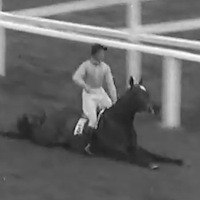Nine Russian Hikers Found Dead - February 26, 1959

On February 26, 1959, nine experienced Russian skiers were found dead approximately one mile from there camp site. Normally, information of this nature would not cause a shockwave to coerce through people, but in this case, several factors contributed to cause a mystery that people are still trying to unravel today.
In 1959, the Communist party ran Russia—the U.S.S.R., the Union of Soviet Socialists Republic. The Space Race was in its infancy, the KGB monitored each citizen’s moves and Khrushchev ruled with an iron fist. All of this information, though seemingly unimportant, would play a significant role in the history-mystery of the Dyatlov expedition.
January 28, 1959, ten students from the Ural Polytechnic Institute in Solikamsk, Russia, set out on an expedition into the Ural Mountains—specifically, Otorten Mountain. Igor Dyatlov, the expedition’s leader, promised to return by February 12, 1959. One of the teams members, Yury Yudin, fell ill near Vizhaj, the last city before the base of the mountain. The other nine went on, never to return alive.
Yurdin awaited word from his friends. Dyatlov confided that they may take longer than the estimated time, so when no word came from the group on the 12th, no one worried. When no word had come by February 20th, however, the families of the missing expeditionists demanded a search. On February 26, 1959, the report came back. The tent had been found with two gaping holes in the side, big enough for people to crawl through. It had been cut from the inside. Evidence in the snow and tent indicated that the party had left in a great hurry, and were either barefoot or in socks. All of them had been dressed in just their sleepwear. All of them had run in the direction of the woods.
Three of the bodies were found closer to the camp—as if they were trying to return. They were identified and determined to have died of hypothermia. Two more were discovered at the edge of the woods, also dead of hypothermia. One of the five had evidence of a skull fracture, but it was determined to be non-fatal. All of the bodies were noted as having an unnatural orange tan and all the hair being turned gray.
Four remained unfound. The search continued for two months. Finally, in May, the other four were found under 4 meters of snow, which is about 12 feet. The autopsy determined that one of these four died of hypothermia. The other three, however, had some rather traumatic internal injuries. One had a crushed skull, the other two had crushed ribs, and one of those, still, was missing her tongue.
As horrifying as this story was, it became even more so when the reports of “orange orbs” in the sky in that area during the months of February and March came out. The Russian government kept the investigation open for three months, then announced they could find no wrongdoer and closed the case, sealing the files. The government also informed those who were part of the search and investigation that they were not to reveal any details about the case. Only recently—circa, 1990—have the case reports, interviews, etc, been released to the public. But, said articles and reports are missing a few key details.
The truth about what happened to the young hikers in the Urals almost 50 years ago may never be discovered. There are, however, an overwhelming amount of theories that range from secret military testing sites to yetis, to UFO’s, to darker paranormal activity. In many of the tales woven by H.P. Lovecraft, his narrator often surmises to his reader, “you may never know for certain. Be thankful for that.” Perhaps that is where this mystery should remain—in the vast, unknown.
For more information on the story, please visit the following resources:
https://www.moscowtimes.ru/stories/2008/02/04/004.html (News Article)
https://www.unexplained-mysteries.com/forum/lofiversion/index.php/t48027.html (if you scroll down a bit on the page, you’ll find a post of the story mostly translated from Russian)
https://en.wikipedia.org/wiki/Dyatlov_pass_accident (the Wikipedia article...)
To discuss theories and ideas about this article, please visit the Today in History forums by clicking on the “Forum” link below or to the left!
In 1959, the Communist party ran Russia—the U.S.S.R., the Union of Soviet Socialists Republic. The Space Race was in its infancy, the KGB monitored each citizen’s moves and Khrushchev ruled with an iron fist. All of this information, though seemingly unimportant, would play a significant role in the history-mystery of the Dyatlov expedition.
January 28, 1959, ten students from the Ural Polytechnic Institute in Solikamsk, Russia, set out on an expedition into the Ural Mountains—specifically, Otorten Mountain. Igor Dyatlov, the expedition’s leader, promised to return by February 12, 1959. One of the teams members, Yury Yudin, fell ill near Vizhaj, the last city before the base of the mountain. The other nine went on, never to return alive.
Yurdin awaited word from his friends. Dyatlov confided that they may take longer than the estimated time, so when no word came from the group on the 12th, no one worried. When no word had come by February 20th, however, the families of the missing expeditionists demanded a search. On February 26, 1959, the report came back. The tent had been found with two gaping holes in the side, big enough for people to crawl through. It had been cut from the inside. Evidence in the snow and tent indicated that the party had left in a great hurry, and were either barefoot or in socks. All of them had been dressed in just their sleepwear. All of them had run in the direction of the woods.
Three of the bodies were found closer to the camp—as if they were trying to return. They were identified and determined to have died of hypothermia. Two more were discovered at the edge of the woods, also dead of hypothermia. One of the five had evidence of a skull fracture, but it was determined to be non-fatal. All of the bodies were noted as having an unnatural orange tan and all the hair being turned gray.
Four remained unfound. The search continued for two months. Finally, in May, the other four were found under 4 meters of snow, which is about 12 feet. The autopsy determined that one of these four died of hypothermia. The other three, however, had some rather traumatic internal injuries. One had a crushed skull, the other two had crushed ribs, and one of those, still, was missing her tongue.
As horrifying as this story was, it became even more so when the reports of “orange orbs” in the sky in that area during the months of February and March came out. The Russian government kept the investigation open for three months, then announced they could find no wrongdoer and closed the case, sealing the files. The government also informed those who were part of the search and investigation that they were not to reveal any details about the case. Only recently—circa, 1990—have the case reports, interviews, etc, been released to the public. But, said articles and reports are missing a few key details.
The truth about what happened to the young hikers in the Urals almost 50 years ago may never be discovered. There are, however, an overwhelming amount of theories that range from secret military testing sites to yetis, to UFO’s, to darker paranormal activity. In many of the tales woven by H.P. Lovecraft, his narrator often surmises to his reader, “you may never know for certain. Be thankful for that.” Perhaps that is where this mystery should remain—in the vast, unknown.
For more information on the story, please visit the following resources:
https://www.moscowtimes.ru/stories/2008/02/04/004.html (News Article)
https://www.unexplained-mysteries.com/forum/lofiversion/index.php/t48027.html (if you scroll down a bit on the page, you’ll find a post of the story mostly translated from Russian)
https://en.wikipedia.org/wiki/Dyatlov_pass_accident (the Wikipedia article...)
To discuss theories and ideas about this article, please visit the Today in History forums by clicking on the “Forum” link below or to the left!

Related Articles
Editor's Picks Articles
Top Ten Articles
Previous Features
Site Map
Content copyright © 2023 by Christa Mackey. All rights reserved.
This content was written by Christa Mackey. If you wish to use this content in any manner, you need written permission. Contact Lane Graciano for details.







